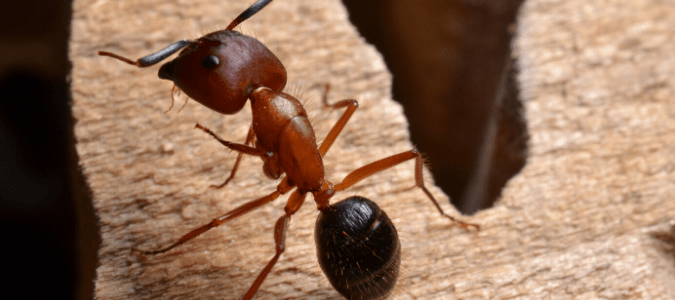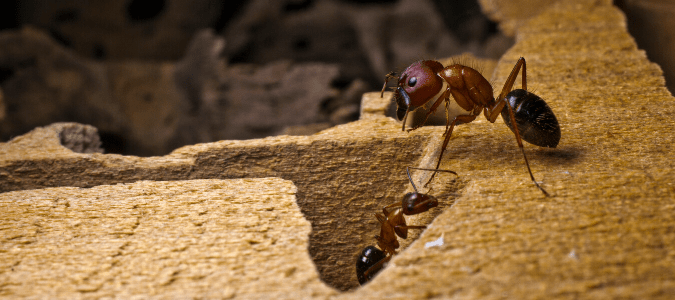
You’ve found what looks like tiny sawdust piles along your baseboards or in your attic crawl space. Then, you spot an ant. After hearing horror stories about the damage these ants can do, you begin to worry that you may have a carpenter ant problem. First, you’ll need to confirm that what you have is actually a Florida carpenter ant and not something else.
Florida carpenter ants have a brown to rusty orange-colored head and thorax with the bottom half of their bodies being black. This ant grows a circular ring of golden hairs around its abdomen. Antennae are bullet-shaped and segmented into 12 parts. Workers measure in at about a quarter of an inch to a half of an inch in length, while winged swarmers and the queen can reach up to three-quarters of an inch long.
If the ants you have seen on your property fit this description, you’ll need to contact a professional. A carpenter ant problem shouldn’t be taken lightly, not only because these insects bite, but also because they can be very destructive.
While carpenter ants aren’t usually interested in biting people or animals, they may do so if they feel threatened. Not only is the initial bite painful, but the formic acid that a carpenter ant sprays on the bite wound afterward makes the area uncomfortable for quite some time. For most, the burning and stinging are similar to a wasp sting and lasts for a few days. For some, however, a bite can trigger an allergic reaction, causing pain and welts that last for more than a week.
Carpenter ants do not consume wood—they tunnel through it—so they aren’t nearly the pest control problem termites can be. That being said, a queen can have a 25-year lifespan, so a colony can be capable of causing extensive damage to any wooden structure over time.
In this post, we’ll discuss how to find a carpenter ant nest, tips on getting rid of these pests and how they are attracted to your home in the first place. As the name “carpenter” suggests, these ants burrow into wood, which is why you might see piles of shavings from the wood damage they cause while excavating areas for nesting. The first step to confirming you have a problem with this variety of pest is finding evidence of a nest.

How To Identify Carpenter Ant Sawdust Piles
As we mentioned previously, carpenter ant sawdust piles are essentially heaps of unwanted material that is pushed out of the nest by ants. These piles are commonly found in attics, basements, foundation walls and porches. The chutes carpenter ants use to eject this debris are commonly referred to as windows. They are usually smooth, oblong slits in wood, and often are the only indicators you have these ants on your property. There will not be any mud-like substances on or near these areas if carpenter ants are the culprit, as these tunnels and other muddy residue would indicate that subterranean termites are more likely present.
While sawdust from carpenter ants often appear to be jagged bits of wood, other debris may also be present: frass. This is the technical term for bodily waste produced by these insects. Carpenter ant frass is excrement from a normal diet made up of other insects and pellet-shaped particles from wood-excavating activities. Frass may indicate that you are closer to the nest than if you’ve only spotted carpenter ant sawdust.
Here are a few things to keep in mind about frass that can aid in identification:
- Debris includes chewed up pieces of wood, feces, bits of soil, fragments of gravel and parts of dead ants and other insects.
- Soft, fibrous crumbles may have the appearance of wood that is loosely compacted together.
- The piles of debris are often cone-shaped.
If you can confirm the wood shavings are left by carpenter ants, you’ll want to bring in a pest professional to recommend a treatment plan. That’s because carpenter ants are more than just a nuisance—they can actually pose a serious danger to your family and pets.
Although you may be able to find carpenter ants and sawdust piles all over your property, locating a carpenter ant nest is the key to implementing effective pest control. Since these pests can bite, and the aftermath can be painful, it’s often easiest to leave this type of work to the professionals.
However, if you decide you want to try to find the nest yourself first, we can provide you with a few tips.

How To Find A Carpenter Ant Nest
Because of their preference for damp areas, you are most likely to find Florida carpenter ants nesting in soft, rotting wood near water leaks or in the pithy interior wood of trees.
The most ideal spaces for carpenter ants to settle are usually:
- Areas close to moisture and food sources
- Enclosed spots safe from birds, lizards and other known predators
- Up off the ground where they are protected from environmental stressors like flooding and excessive heat
- Places easily accessible from the outside
Inside the home, hollows such as wall voids behind the dishwasher or within porch columns are two of the most common spaces carpenter ants choose. They may also nest under sinks and bathtubs and near poorly sealed windows and door frames. If you have roof leaks or poor flashing around your chimney, carpenter ants might use these spots to make their way in.
Because these pests can hurt you if they see you as a threat, be careful when you’re searching for the nest. Some common techniques to find a carpenter ant nest include:
- Softly probing wood exteriors with a screwdriver, keeping an eye out for excavated carpenter ant galleries.
- Tapping along wooden surfaces, listening for the hollow sound of damaged wood.
- For an active colony, listening for the “rustling sounds” inside a potential nest. Some describe these noises as similar to cellophane crinkling.
While there are some varieties of carpenter ant that prefer to tunnel into new wood, Florida carpenter ants typically look for existing voids and only excavate softer, already-rotting materials.
Carpenter ants are more likely to be inside your home at night when they are foraging for food. If you have the time and patience, wait for them to emerge to attempt to find the nest.
Follow the trailing forager ants back to the primary site and treat the issue there. If you only treat satellite nests, the ants are likely to simply move the satellite and continue causing problems inside your home. Of course, there are numerous species of ants and several types of carpenter ant at that. Make sure the forager ants you’re following are, in fact, carpenter ants before you implement a treatment program.
With several types of Florida carpenter ants, homeowners may begin to wonder what brought these ants to their property in the first place and what they can do to prevent a future infestation.

What Attracts Carpenter Ants To Your Home
There are three primary things that attract Florida carpenter ants to your property: food, moisture and vegetation.
Food
Like their rather docile cousin, the sugar ant, the carpenter ant has a sweet tooth and can often be found where sugar- and carbohydrate-laden foods are readily available. Floral nectars and honeydews produced by sucking insects such as aphids and mealybugs can also draw their attention. Carpenter ants seek out proteins during the height of reproduction in the form of other insects. Some of the favorite foods during these periods include grasshoppers, crickets, honeybees and caterpillars. The brood-production cycle is in full swing throughout the summer months.
Some of a carpenter ant’s favorite household food items include:
- Syrup, honey and jelly
- Candy
- Meat
- Pet food
To eliminate readily available food sources for these pests, place all these items in tightly sealed containers, sweep and mop regularly, wipe down counters after using them, clean dishes promptly and take out your trash regularly.
Moisture
As we’ve already mentioned, Florida carpenter ants prefer damp environments. Soft, rotting wood or wooden materials that were previously weakened by other pests is their favorite because it makes their job easier. Fix any leaks on your property and have rotting trees or tree stumps removed, especially if they are close to your home. Have a professional inspect your home, if you haven’t already, to ensure that your attics and crawlspaces are well ventilated so no excess moisture is providing insect or animal pests with a reason to stick around.
Vegetation Leading To Your Home
Many homeowners place piles of firewood up against their homes because it is convenient to grab logs when they want to start a fire. Not only is scrap wood and other vegetation something that attracts carpenter ants, unfortunately, but termites and cockroaches also find these materials appealing. When these materials are location against the exterior of your home, you’re providing these pests with a path right to your doorway. For this reason, all organic materials, including tree stumps, should be moved at least 15 feet away from your foundation. While you are at it, trim back any tree branches or bushes that could allow carpenter ants to easily travel to your home.
Once you’ve found the nest and made your home as unattractive to these pests as possible, you’ll want to begin treatment. Although homeowners may experiment with natural remedies before bringing in a professional, these methods are not scientifically proven and usually ineffective.

Using Natural Carpenter Ant Killers
Home remedies for carpenter ants usually only kill ants they come in contact with. At best, you’ll just slow the growth of the colony on your property. Some homeowners try the following methods while waiting for a professional treatment plan to begin:
- A mixture of sugar and baking soda placed in shallow bowls along areas where these ants normally travel. While there is no scientific proof to back this up, some say that baking soda kills ants.
- Dampen a cotton ball or kitchen towel with essential oils and wipe it along the trails where these ants travel. It is believed that these scents can affect the pheromone trails ants use for navigation and communication.
- Put a mixture of dish soap and water into a spray bottle and spray all visible ants with this mixture.
You may have heard that pouring boiling water into a carpenter ant nest is a good idea. This technique is usually ineffective because most homeowners don’t have enough boiling water to neutralize the entire nest and there is no easy way to determine exactly how big a nest is. This is also risky becuase you’re putting yourself in danger of being the victim of carpenter ant bites. Eliminating the entire colony is best left to a professional who has the tools and protection for carpenter ant removal and control.
While there are a number of products on the market advertised as natural or safe to use around family members and pets, an experienced pest control service is your best bet for proper treatment. Talk to an expert about your options for treating a carpenter ant infestation in and around your home to determine your best next steps. Carpenter ants are resilient, so natural ant killers are rarely effective for eliminating an entire colony without other complementary treatment efforts.
ABC Can Eliminate Ants From Your Property
Due to the destructive nature of these pests and the fact that they bite, the quickest and easiest way to resolve a carpenter ant problem is often to contact a pest control professional. The experienced technicians at ABC Home & Commercial Services can locate both carpenter ant nests and satellite nests and implement a holistic, effective treatment plan. After we’ve eliminated all of the carpenter ants on your property, we will put preventative measures in place to ensure you don’t have to deal with these pests again.